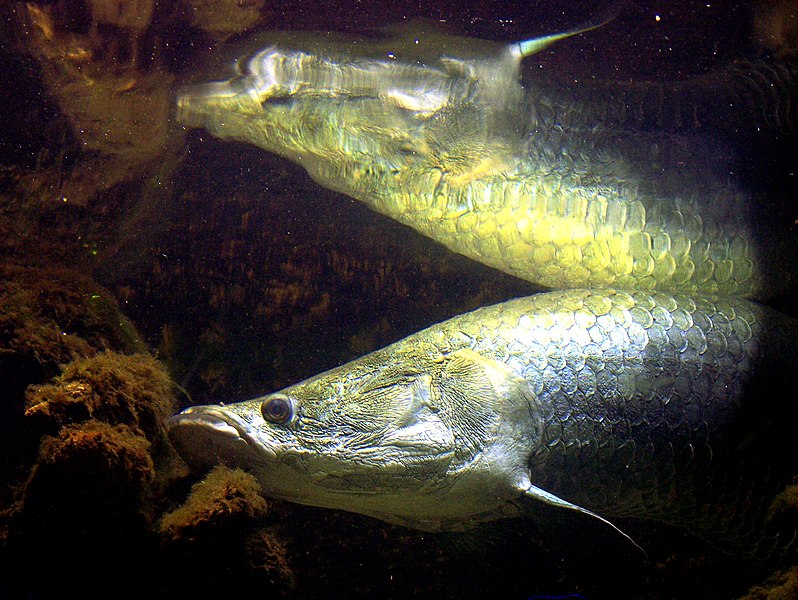File:Arapaima gigas 5147.jpg
- Rikcha
- Willañiqip wiñay kawsaynin
- Maypim willañiqita llamk'achinku
- Mayqin wikikunapi willañiqita llamk'achinku
- Metadata

Qallariy willañiqi (2832 × 2128 iñu; willañiqip chhikan kaynin: 2,54 MB; MIME laya: image/jpeg)
Leyendas
Leyendas
Pisichay[llamk'apuy]
| T'iktunaArapaima gigas 5147.jpg |
Taxonomy (with index of trivial names): Description:
Arapaima reaches lengths of up to 3 metres (10 ft.) and weigh up to 200 kg (440 lbs.).
The front body is bronze green. There are red spots in middle to tail section, and the tail is orange and green mottled. Distribution (without world wide fish farming):
The largest scaled freshwater fish in the world lives only in north-eastern South America; particularly in the Guyana Shield and the Amazon River Basin. The Makushi, the second largest indigenous group in Guyana and the third largest in Brazil call the fish - Warapai. Some aspects of fish biology: The swim bladder of the arapaima is open to the pharynx and the fish uses the bladder which is rich in blood vessels as a lung. The adult arapaima surfaces every 18-20 minutes and juveniles every 5 minutes for gulping air. Due to their ability to breath air from the surface arapaima can survive oxygen depletion and extensive drought periods by burrowing in the mud. The father guarding the eggs is known to take them in his mouth and move them to another location. The young are led by the male in a group once they are able to swim. iwokrama |
| P'unchaw | |
| Pukyu | Kikinpa rurasqan |
| Ruraq | T.Voekler |
Saqillaspa[llamk'apuy]
- Qispilla rurarillay:
- rakinakuy – iskaychay, mast'ariy, maymanpas kachay kay rurasqata
- musuqmanta chaqruy – rurasqata tupayay
- Kay phatakuna tukuptinqa:
- Ruraqpa sutinta willay – Kay rurasqataqa ruraqninpa icha saqillaqninpa sut'ichasqan hina unanchanaykim (ichataq amapuni kay hinachu, pay q'imisunkiman icha rurayniykita q'iminman rikch'akunman).
- Kay hinallataq rakinakuy – Kay rurasqata hukchaspayki wakinchaspayki icha paymanta musuqta ruraspaykiqa, musuq rurasqaykita kikillan icha payman kaqlla saqillayllawanmi mast'arinkiman.
Willañiqip wiñay kawsaynin
P'unchaw/pacha nisqapi ñit'iy chaypacha willañiqi kachkasqata qhawanaykipaq.
| P'unchaw/Pacha | Uchuylla rikchacha | Chhikanyachikuqkuna | Ruraq | Willapuy | |
|---|---|---|---|---|---|
| kunan | 07:12 14 ini 2020 |  | 2832 × 2128 (2,54 MB) | Togabi (rimanakuy | llamk'apusqakuna) | Color Adjustment. |
| 22:28 23 nuw 2007 |  | 2832 × 2128 (1,44 MB) | Teacoolish (rimanakuy | llamk'apusqakuna) | {{Information |Description= Arapaima gigas (Schinz, 1822) Family: Arapaimidae - band fishes, bony tongues; Named in Brazil: Pirarucù, Warapai, Bodeco, Bodequinho Peru and Ecuador: Paiche Guyana: Warapai Colombia: De-chi, Pirarucù, Paiche, Ticuna Ecuador |
Manam atinkichu kay willañiqita huknachayta.
Maypim willañiqita llamk'achinku
Kay rikchamanqa kay qatiq 2 p'anqakunam t'inkimun:
Mayqin wikikunapi willañiqita llamk'achinku
Kay wakin wikikunam willañiqitaqa llamk'achinku:
- azb.wikipedia.org-pi kaykunapi llamk'achinku
- de.wiktionary.org-pi kaykunapi llamk'achinku
- en.wikipedia.org-pi kaykunapi llamk'achinku
- incubator.wikimedia.org-pi kaykunapi llamk'achinku
- pt.wikibooks.org-pi kaykunapi llamk'achinku
- qu.wikipedia.org-pi kaykunapi llamk'achinku
- species.wikimedia.org-pi kaykunapi llamk'achinku
Metadata
Kay willañiqipiqa aswan sapaqlla willaymi, iliktruniku rikchahap'inawanchá, iskanirwanchá icha rikcharurana wakichiwanchá yapasqa. Willañiqi chaymantapacha hukchasqa kaptinqa, huk sapaq samiqninkuna chinkasqachá.
| Rikcha hap'inap ruraqnin | EASTMAN KODAK COMPANY |
|---|---|
| Rikcha hap'ina kayma | KODAK Z650 ZOOM DIGITAL CAMERA |
| Churapay pacha | 1/8 sikundu (0,125) |
| F huchha | f/3,2 |
| ISO utqay chayninchay | 160 |
| Willakunap kamaynin p'unchaw, pacha | 17:12 8 nuw 2007 |
| Lintip rawray karu kaynin | 13,7 mm |
| Puririchiy | Sapsi |
| Siriqpa ch'irkukun | 230 ppp |
| Sayaqpa ch'irkukun | 230 ppp |
| Llamk'achisqa llamp'u kaq | GIMP 2.10.8 |
| Willañiqi hukchay p'unchaw, pacha | 14:10 14 ini 2020 |
| Y-ta C-tapas churamuy | Chawpichasqa |
| Churapana wakichi | Sapsi wakichi |
| Exif rikch'ay | 2.21 |
| Antañiqichay p'unchaw, pacha | 17:12 8 nuw 2007 |
| Sapa ñawpariqninpa sut'in |
|
| APEX wichq'aqpa utqaynin | 3 |
| APEX illa k'ichkina | 3,4 |
| Churapay pantapayay | 0 |
| Illa k'ichkinap lliwmanta aswan chanin | 3,4 APEX (f/3,25) |
| Tupuy laya | Qatinalla |
| K'anchay pukyu | Mana riqsisqa |
| Illapu | Manam pinchi illaparqanchu, pinchi illapana manam kachunchu |
| Saqillasqa Flashpix rikch'ay | 1 |
| Llimphi suyu | sRGB |
| Churapay rikuchiq | 160 |
| Musyachiq laya | Ch'ulla antañiqiq chhillpa llimphi suyu musyachiq |
| Willañiqip pukyun | Ruk'aqta sayaq rikch'a hap'ina |
| Rikuypacha laya | Chiqalla hap'isqa rikcha |
| Rikcha llamk'apuyta sapaqchay | Sapsi ruraykuy |
| Churapay laya | Kikinmanta churapay |
| Yuraq paqtaku | Kikinmanta yuraq paqtanaku |
| Iliktruniku sichpachinap (zoom nisqap) achuraynin | 0 |
| 35 mm pilikulapi rawray karu kay | 82 mm |
| Rikuypacha hap'iy laya | Hukyachisqa |
| Rikuypacha llanchiy | Aslla chaskiy miray |
| Achki hayu | Sapsi |
| Sasay | Sapsi |
| K'awchi kay | Sapsi |
| Rikchachasqap karu kay patayaykun | Mana riqsisqa |
| Qallariy qillqarimap sapaqlla kikinchakuynin | xmp.did:33677ae2-1d13-4cba-8271-dfa93d43c7b8 |